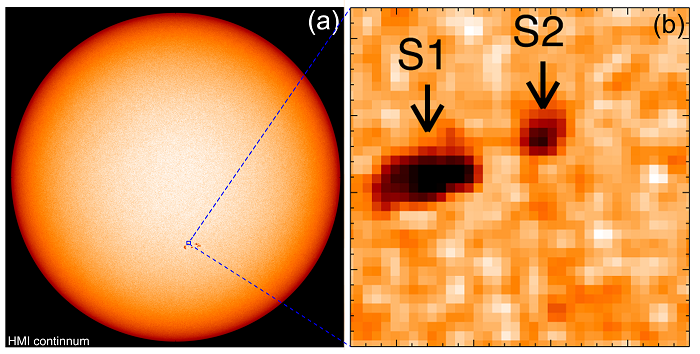Sunspots are dark regions with strong magnetic fields and low temperature in the atmosphere of the Sun. Their appearance and disappearance are the result of the evolution of solar magnetic fields. Therefore, they play a key role in understanding the solar cycle and the origin of solar magnetic fields. However, until now, it is not clear how sunspots decay or disappear from the surface of the Sun.
While magnetic reconnection is theoretically believed to be a mechanism of sunspot decay. It is a physical process in which two sets of opposite magnetic loops approach and interact with each other, and finally exchange their footpoints. Magnetic energy is transformed into kinetic and heat energy of plasma. The Sun is the best laboratory for studying magnetic reconnection, because magnetic reconnection is often regarded as one mechanism for triggering the eruption in the solar atmosphere.
Dr XUE Zhike et al. studied the rapid decay of solar pores driven by small-scale magnetic reconnection, using the high-resolution data obtained by the 1-meter New Vacuum Solar Telescope (NVST) at the Fuxian Solar Observatory of Yunnan Observatories, the Chinese Academy of Sciences. The results have been published recently in The Astrophysical Journal Letters.
XUE et al. discovered that the decay of the pores occurred in a small region of the Sun on 2020 October 26 (Figure 1(a)). A small pore (S2, positive magnetic pole) gradually formed and approached another existing small pore (S1, negative magnetic pole) (Figure 1(b)), and then the two pores gradually disappeared from the surface of the Sun. By calculating the decay rates of the area and the magnetic flux of S2, researchers found that the decay of S2 belongs to a fast mode.
A small-scale magnetic reconnection was clearly observed by the NVST and Solar Dynamics Observatory (SDO) in the solar chromosphere and corona. It occurred between the two sets of magnetic loops rooted in S1 and S2 respectively, and finally resulted in the formation of the magnetic loops connecting S1 and S2 above the photosphere.
The observational results reveal that the disappearance of the pore was first driven by the small-scale magnetic reconnection, and then the magnetic field loops connecting S1 and S2 submerged below the solar photosphere, so that the pores cannot be observed. It is believed that a magnetic reconnection is an efficient mechanism of solar pore decay. (within 10 days)

Figure 1. The Sun and solar pores. The field of view (FOV) of panel (b) is indicated by the blue rectangle in panel (a).The pores are marked by the black arrows.(Image by XUE Zhike)
Contact:
XUE Zhike, Yunan Observatories, CAS
zkxue@ynao.ac.cn